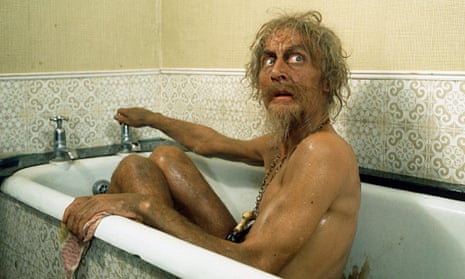Most of the shows from your childhood are rubbish. The odd YouTube moment aside, you probably won’t be able to revisit one episode of T-Bag or Worzel Gummidge without squirming. Catweazle, a Worzel precursor from 1970, was different, never taking its eye off its characters’ fragility while offering the necessary mayhem to keep both kids and grown-ups hooked. Inspired by a word on a gate that writer Richard Carpenter made note of, Catweazle told the adventures of an inept medieval magician whose flying spell backfires, sending him forward in time to Hexwood Farm circa 1969. Here, he encounters colour TVs, fridges and people talking into the “telling bone”. He also, very carefully, breaks your heart: think of the end of The Snowman, or Gromit leaving home in The Wrong Trousers. Catweazle packs a similar punch.
Portrayed by stage actor Geoffrey Bayldon, Catweazle was a hero to bunglers everywhere. After jumping into a moat to flee Norman invaders, the wizard wakes up in a drainage pond, and stumbles on to a farm where he meets a teenager called Carrot, played by Robin Davies. On the surface, the show was about Carrot humouring the wizard and trying to shield him from the outside world (and, having seen the magician’s keenness to pull his crystal dagger on strangers, trying to shield the outside world from him). Underneath that, though, it was about a boy confined to a farm who escapes loneliness by helping a stranger who is twice as isolated as he is, and also away with the fairies.
While the first season secretly taught science to kids by having a boy explain it to an adult (Catweazle experimenting with “elec-trickery” was always a highlight), series two upped the slapstick. The location shifted to a country manor house, presumably in a bid to sell the franchise to America. There are some brilliant touches – Catweazle finds grenades! – but less of the original’s poignancy, such as Carrot explaining his mum’s absence, or facing the inevitability of school.
Carpenter’s writing used dialogue-free scenes to make the best of Bayldon’s physicality, and coaxed sympathetic moodiness from Davies. The pair become “brothers”, with Catweazle refusing to let his mate succumb to boredom, luring him out of his farm, nicking crystal balls from junk shops and denouncing as a Norman anyone who says no to him. His man out of his time routine is as deft as The Terminator while his catchphrase – “Nothing works!” – seems more relevant than ever. A movie adaption has been touted for decades, with Bafta-winning director John Henderson on board, and Rhys Ifans tipped for the lead.
Ifans wouldn’t be the first star seduced by the show. Carpenter’s scripts secured some noteworthy cameos for their time, including Hattie Jacques as a fortune teller and Aubrey Morris (better known as A Clockwork Orange’s Mr Deltoid) as a shopkeeper. The show builds to that crucial moment – the heartbreak – with a scene that would leave even the hardiest of adults wiping a tear away. As Catweazle departs for the 11th century, a flute plays a melancholy air, Carrot’s voice deepens and the old man fades away. “Will you come back one day?” cries Carrot.

Comments (…)
Sign in or create your Guardian account to join the discussion